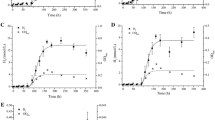Abstract
Ruminal cellulolytic bacteria (Fibrobacter succinogenes S85 or Ruminococcus flavefaciens FD-1) were combined with the non-ruminal bacterium Clostridium kluyveri and grown together on cellulose and ethanol. Succinate and acetate produced by the cellulolytic organisms were converted to butyrate and caproate only when the culture medium was supplemented with ethanol. Ethanol (244 mM) and butyrate (30 mM at pH 6.8) did not inhibit cellulose digestion or product formation by S85 or FD-1; however caproate (30 mM at pH 6.8) was moderately inhibitory to FD-1. Succinate consumption and caproate production were sensitive to culture pH, with more caproic acid being produced when the culture was controlled at a pH near neutrality. In a representative experiment under conditions of controlled pH (at 6.8) 6.0 g cellulose 1−1 and 4.4 g ethanol 1−1 were converted to 2.6 g butyrate 1−1 and 4.6 g caproate 1−1. The results suggest that bacteria that efficiently produce low levels of ethanol and acetate or succinate from cellulose should be useful in cocultures for the production of caproic acid, a potentially useful industrial chemical and bio-fuel precursor.
Similar content being viewed by others
References
Bornstein BT, Barker HA (1948) The nutrition of Clostridium kluyveri. J Biol Chem 55:223–230
Budavari S (ed) (1989) The Merck index: an encyclopedia of chemicals, drugs, and biologics. 11th edn, Merck, Rahway, NJ, p 266
Dehority BA (1971) Carbon dioxide requirement of various species of rumen bacteria. J Bacteriol 105:70–77
Gaudet G, Forano E, Dauphin G, Delort AM (1992) Futile cycling of glycogen in Fibrobacter succinogenes as shown by in situ 1H-NMR and 13C-NMR investigation. Eur J Biochem 207:155–162
Hungate RE (1966) The rumen and its microbes. Academic Press, New York, pp 194–195
Kenealy WR, Waselefsky DM (1985) Studies on the substrate range of Clostridium kluyveri: the use of propanol and succinate. Arch Microbiol 141:187–194
Khan AW, Patel GB (1991) Cellulose degradation by mesophilic anaerobic bacteria. In: Haigler CH, Weimer PJ (eds) Biosynthesis and biodegradation of cellulose, Dekker, New York, pp 355–375
Levy PF, Sanderson JE, Ashare E, Wise DL, Molyneaux MS (1980) Liquid fuels production from biomass. United States Dept of Energy Report DOE/ET/20050-T4, US Department of Energy, Washington, DC
Levy PF, Sanderson JE, Kispert RG, Wise DL (1981) Biorefining of biomass to liquid fuels and organic chemicals. Enzyme Microb Technol 3:207–215
Levy PF, Sanderson JE, Ashare E, Riel SR de (1983) Alkane liquid fuels production from biomass. In: Wise DL (ed) CRC liquid fuels developments, CRC Boca Raton, Fla, pp 159–188
Montgomery L, Flesher BA, Stahl DA (1988) Transfer of Bacteroides succinogenes (Hungate) to Fibrobacter gen. nov. as Fibrobacter succinogenes comb. nov. and description of Fibrobacter intestinalis. Int J Syst Bacteriol 38:430–435
Pavlostathis SG, Miller TL, Wolin MJ (1988a) Fermentation of insoluble cellulose by continuous cultures of Ruminococcus albus. Appl Environ Microbiol 54:2655–2659
Pavlostathis SG, Miller TL, Wolin MJ (1988b) Kinetics of insoluble cellulose fermentation by continuous cultures of Ruminococcus albus. Appl Environ Microbiol 54:2660–2663
Sauer ET (1992) Carboxylic acids: economic aspects. In: Howe-Grant M (ed) Kirk-Othmer encyclopedia of chemical technology, 4th ed, vol 5, Wiley-Interscience, New York, pp 179–187
Schaefer DM, Davis CL, Bryant MP (1980) Ammonia saturation constants for predominant species of rumen bacteria. J Dairy Sci 63:1248–1263
Shi Y, Weimer PJ (1992) Response surface analysis of the effects of dilution rate and pH on Ruminococcus flavefaciens in cellulose-fed continuous culture. Appl Environ Microbiol 58:2583–2591
Siegfried VR, Ruckemann H, Stumpf G (1984) Eine HPLC-Methode zur Bestimmung organischer Sauren in Silagen. Landwirtsch Forsch 37:298–304
Weimer PJ (1992) Cellulose degradation by ruminal microorganisms. CRC Crit Rev Biotechnol 12:189–223
Weimer PJ (1993) Effects of dilution rate and pH on the ruminal cellulolytic bacterium Fibrobacter succinogenes in cellulose-fed continuous culture. Arch Microbiol 160:288–294
Weimer PJ, Lopez-Guisa JM, French AD (1990) Effect of cellulose fine structure on kinetics of its digestion by mixed ruminal microorganisms in vitro. Appl Environ Microbiol 56:2421–2429
Weimer PJ, Shi Y, Odt CL (1991) A segmented gas/liquid delivery system for continuous culture of microorganisms on insoluble substrates and its use for growth of Ruminococcus flavefaciens on cellulose. Appl Microbiol Biotechnol 36:178–183
Wells JE, Russell JB (1994) The endogenous metabolism of Fibrobacter succinogenes and its relationship to cellobiose transport, viability, and cellulose digestion. Appl Microbiol Biotechnol 41:471–476
Author information
Authors and Affiliations
Additional information
Mention of specific products is intended only to provide information and does not contitute an endorsement by the U.S. Department of Agriculture over other products not mentioned.
Rights and permissions
About this article
Cite this article
Kenealy, W.R., Cao, Y. & Weimer, P.J. Production of caproic acid by cocultures of ruminal cellulolytic bacteria and Clostridium kluyveri grown on cellulose and ethanol. Appl Microbiol Biotechnol 44, 507–513 (1995). https://doi.org/10.1007/BF00169952
Received:
Revised:
Accepted:
Issue Date:
DOI: https://doi.org/10.1007/BF00169952




